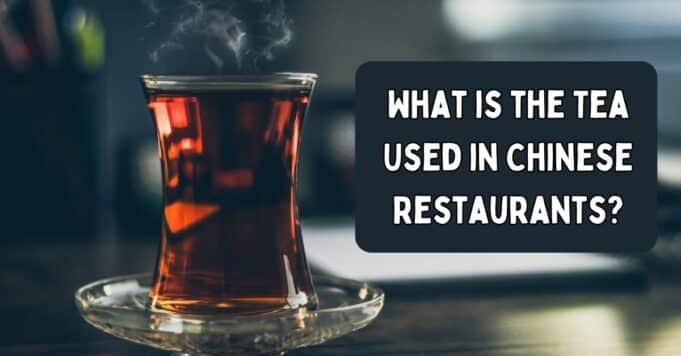When dining at a Chinese restaurant, many people are familiar with the soothing cup of tea that is served before the meal begins. This tea isn’t just a beverage—it’s an integral part of Chinese culture and dining etiquette. But have you ever wondered what type of tea is served in Chinese restaurants and why?
In this article, we will explore the different types of tea used in Chinese restaurants, their traditions, and how they enhance your dining experience.
Cultural Importance of Tea in China
In Chinese culture, tea is not just a beverage; it holds significant cultural value. It symbolizes respect, hospitality, and harmony. The act of offering tea to guests is a gesture of goodwill and a way to show honor. Whether at a family gathering, business meeting, or formal occasion, tea plays a vital role in fostering relationships and demonstrating respect.
In traditional Chinese tea ceremonies, the preparation and serving of tea is an art form that requires skill and mindfulness. Each step is done with care, from warming the teapot to pouring the tea in a precise, controlled manner.
Tea also plays an important role in Chinese medicine. It is believed that different teas offer a variety of health benefits, from improving digestion to balancing the body’s energy (qi). Many Chinese restaurants take this into account when choosing the teas they serve, as they aim to provide not just a refreshing drink but one that promotes well-being.
Read: Can You Freeze Cream Cheese?
Types of Tea Commonly Served in Chinese Restaurants
1. Green Tea
Green tea is one of the most commonly served teas in Chinese restaurants. Known for its light, refreshing taste, it is made from unoxidized tea leaves, which preserves the natural green color and delicate flavor. The tea is typically brewed at a lower temperature to avoid bitterness.
Why it’s used: Green tea is believed to aid digestion and balance the rich, savory flavors found in Chinese cuisine. It is often served before or during a meal to cleanse the palate between dishes.
Popular green teas in Chinese restaurants:
- Longjing (Dragon Well): A premium green tea known for its flat, spear-like leaves and sweet, vegetal taste.
- Biluochun: A fragrant green tea from the Jiangsu province, known for its delicate, floral aroma.
2. Oolong Tea
Oolong tea is a partially fermented tea that falls between green and black tea in terms of oxidation. It has a smooth, slightly floral flavor with a lingering sweetness. In Chinese restaurants, oolong tea is often served in a more concentrated form, making it a popular choice for pairing with rich and flavorful dishes.
Why it’s used: Oolong tea is thought to aid in digestion, particularly when consumed alongside fatty or oily dishes, such as dumplings or Peking duck.
Popular oolong teas in Chinese restaurants:
- Tie Guan Yin: Known for its fragrant and floral aroma with a sweet, creamy flavor.
- Da Hong Pao: A famous oolong tea from the Wuyi Mountains with a robust, smoky taste.
3. Jasmine Tea
Jasmine tea is a fragrant, flavored tea made by infusing green tea leaves with jasmine flowers. It is sweet, fragrant, and soothing, often served as a dessert tea after a meal. This type of tea is especially popular in Chinese restaurants, thanks to its delicate and refreshing aroma.
Why it’s used: Jasmine tea is often enjoyed for its calming properties and ability to refresh the palate after a meal.
Popular jasmine teas in Chinese restaurants:
- Jasmine Green Tea: Made by blending green tea with jasmine flowers, this tea has a light and fragrant flavor.
- Jasmine Pearl Tea: This tea is hand-rolled into small pearls that unfurl when brewed, offering a more aromatic experience.
4. Pu-erh Tea
Pu-erh tea is a unique and highly regarded fermented tea from the Yunnan Province of China. It is aged and undergoes a fermentation process, which gives it a distinctive earthy, deep flavor. Pu-erh is often served in Chinese restaurants as a post-meal tea, as it is believed to help with digestion and weight management.
Its strong, sometimes musty taste may not appeal to everyone, but for those who enjoy its bold profile, pu-erh tea is a great companion to a heavy meal.
Read: Panama Food Delights
How is Tea Served in Chinese Restaurants?
In Chinese restaurants, tea is typically served in small cups, often without handles. The tea is poured directly from a teapot into these cups. The practice of serving tea is also accompanied by certain etiquettes that are rooted in tradition.
Serving Etiquette
In more traditional settings, it is customary for the waiter or restaurant staff to serve the tea and for guests to tap their fingers on the table to show appreciation. This is a symbolic gesture of gratitude that has roots in Chinese culture, where it is believed that the act of tapping the table shows respect for the person serving.
Traditional Tea Ceremony
Some high-end Chinese restaurants may offer a full tea ceremony, where the tea is prepared and served with careful attention to detail. This ceremony can involve the use of special tea vessels, and the tea may be steeped multiple times to draw out different layers of flavor.
The Importance of Tea in Chinese Dining Culture
1. Tea as a Welcoming Gesture
In Chinese culture, offering tea to guests is a sign of respect and hospitality. The tradition of serving tea in restaurants is rooted in these cultural practices. Tea is often offered as a greeting when you sit down, setting the tone for the meal.
2. Enhancing the Dining Experience
Tea in Chinese restaurants is carefully chosen to complement the meal. The various flavors and aromas of the tea help cleanse the palate between bites, allowing diners to fully appreciate the different textures and tastes of the food.
3. Digestive Benefits
Many Chinese teas, such as green tea and oolong tea, are known for their digestive properties. They help break down fatty foods and promote smoother digestion, which is especially important after a heavy meal. Tea also helps prevent bloating, making it an essential part of the dining experience.
Read: 5 Trendy BGC Restaurants to Try Delicious Food in This Week
How to Enjoy Tea in Chinese Restaurants?
Tea Etiquette
When drinking tea in a Chinese restaurant, it is common to pour tea for others before pouring for yourself. This gesture of serving others first shows respect and hospitality. Additionally, it’s customary to drink the tea without any additives like sugar or milk, allowing the natural flavors of the tea to shine through.
Tea Pairing Tips
Pairing tea with the right dish enhances the dining experience. For example, jasmine tea pairs well with lighter dishes such as spring rolls or dim sum, while oolong tea is better suited for heavier, meatier dishes like roast duck or pork.
Health Benefits of Chinese Tea
Tea, particularly the varieties served in Chinese restaurants, offers a range of health benefits:
Rich in Antioxidants
Many types of Chinese tea, such as green and oolong tea, are rich in antioxidants, which help protect the body from damage caused by free radicals. These antioxidants are believed to support heart health, reduce inflammation, and prevent chronic diseases.
Aid for Digestion
As mentioned earlier, certain types of tea, like oolong and pu-erh, are known to help with digestion. These teas can stimulate the digestive system, making them an excellent choice after a heavy or rich meal.
Helps with Hydration
Tea is a hydrating beverage, and drinking it throughout a meal can contribute to your overall fluid intake. In Chinese cuisine, where meals may be spicy or heavily flavored, tea can help replenish lost fluids and keep you hydrated.
Read: What’s So Special About Buc-ee’s?
Conclusion
Tea in Chinese restaurants is more than just a beverage—it’s an essential part of the dining experience, rich in tradition and cultural significance. Whether it’s the refreshing taste of green tea, the complex flavors of oolong, or the floral fragrance of jasmine tea, each type plays a unique role in complementing the meal and enhancing your overall experience. Next time you visit a Chinese restaurant, take a moment to savor the tea, appreciate the cultural practices behind it, and enjoy the connection between food, flavor, and tradition.
By understanding the various teas served in Chinese restaurants and their significance, you can deepen your appreciation of this integral aspect of Chinese cuisine and hospitality.















